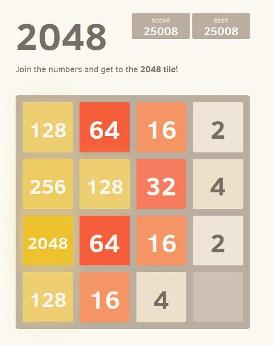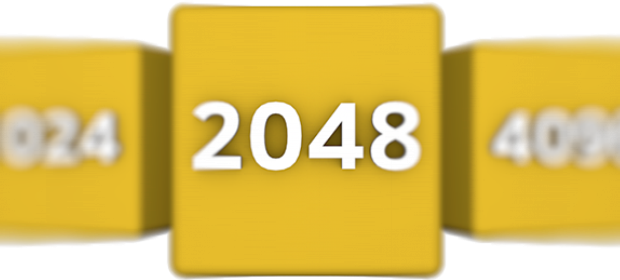With allegations of plagiarism, bad blood between games developers, comparisons to the excellent Flappy Bird, and a plethora of open-source tweaked versions, 2048 is certainly the most controversial nerdy maths puzzle on the market in 2014. Forget about all this, and the fact that it is eerily similar to Threes!, which surfaced just prior to its release, though, m’kay? You have to tip your hat to Gabriele Cirulli: he may have a lasses’ name, but the 19 year old whiz managed to drum up squillions of downloads (and probably even more clone tributes and HTML players) for his simple yet addictive take on tile-sliding puzzle fury.
For the uninitiated, 2048 is based around a very basic premise: a grid comprising sixteen squares, in which you slide numbered tiles. Each time you slide a tile it will continue in its intended direction until it reaches either the edge of the grid, or another tile. When you pair numbers together, they will multiply – so bonding two “2” tiles will create an “8”, and so on and so forth – until you eventually make the magic number of 2048. It provides an interesting choice over how you approach things, and even haphazardly flicking tiles all over the place can sometimes yield results. This is a classic casual title that can be dipped into for some quick thrills, yet you can also put your mathematician’s hat on (one of those black scholarly ones, innit) and approach the puzzle methodically with a view to maximising your score on your way to the prized four digits.

This 3DS conversion comes with some attractive features. There are three different modes, allowing you to aim for three different goal totals – 1024, 2048 and 4096. A set of tutorial screens guides you into the “action”, and will help if, like me, this looks like a Sudoku puzzle on the surface, as opposed to a brisk and actually mildly thrilling puzzler.
The 3D viewpoint is aesthetically pleasing and works well – this is the epitome of low-gloss, efficient functionality. Controls are well implemented, too, and there are options to use either the touchscreen or the analogue stick. The price point, and amount of space it occupies on your SD card, are both minimal. There are a bunch of achievements to unlock, and a decent sense of score attack, as your best total is always displayed on screen to spur you on – even though anyone with a basic knowledge of the way 2048 works will know that even when you have hit the required number, there is a maximum possible score.
VERDICT: 2048 isn’t particularly challenging, and doesn’t require zen-like levels of skill and concentration to defeat it. It is one of those games like Nokia’s “Snake” from the late 90s, Game Boy Tetris, and Lumines, that I can see myself dipping into regularly, a simple, casual handheld experience that doesn’t ask too much of me, and can easily while away half an hour waiting for a bus. Non-3DS-owning Nintendo fans take note: you can also enjoy a perfectly good game of 2048 using the Wii U browser.

GOOD. A game that scores 7/10 is worthy of note, but unworthy of fanfare. It does many things well, but only a few of them incredibly well and, despite a handful of good qualities, fresh ideas and solid mechanics, it fails to overwhelm.
Review code provided by publisher.





